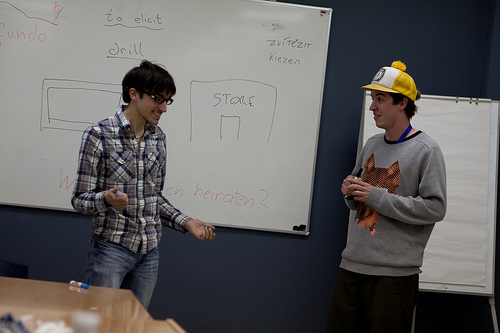SVC型(第2文型)の用例(再考)
He is a teacher.(彼は先生です)のようにS(主語)+V(述語動詞)+C(補語)の順で並んでいる構文を第2文型と呼びます。動詞は自動詞ですが、Vの後にCを必要とするので、不完全自動詞と呼ばれています。(なお、完全自動詞はVの後に何もつかないものです)
典型的な例として次のような文が挙げられます。
(a) James is a capable teacher.
(b) Seeing is believing.
(c) It sounds very strange.
(d) This medicine tastes bitter.
(e) The weather has been extremely cold all this month.
補語とは何か
補語(complement)とは述語動詞の後に来て述語動詞の機能を補うものです。名詞や形容詞(あるいは、名詞や形容詞の働きをする節や句)が補語となります。大きな特徴として、主語=補語の関係が成立することです。上の(a)~(e)の例で言えば、James = a capable teacher, Seeing=believing, It = strange, This medicine = bitter, The weather = cold という関係が成立します。
さまざまな特徴
第2文型は動詞の性格によって、いくつかに分類されます。
(A) 状態を示す動詞として、 主としてbe動詞が使われますが、他の動詞としてlie, sit, stand, remain, keepもあります。
It was dark in that hall. (そのホールは暗かった)
She remained silent in front of him.(彼女は彼の前では沈黙したままだった)
(B) 状態の変化を示す動詞として、 become, get, go, come, grow, fall などがあります。それぞれには次の特徴があります。
becomeは硬い表現で、getは口語的な表現です。goは悪い状態への変化、comeは良い状態への変化を示します。growは徐々に起こる変化、fallは悪い状態への急激な変化、turnは単に状態の変化を示します。
1. He became a dentist two years ago.
2. It is getting colder day by day.
3. The milk has gone sour.
4. His dream came true.
5. The sky grew darker and darker.
6. My grandmother fell ill.
7. Mr. Sato fell victim to a stroke.
8. Leaves in this mountain turn red in autumn.
(C) 外見を示す動詞 「~のように見える、思われる」という意味の動詞として、seem, appear, lookがあります。
9. He seems angry about something.
10. She seems to be interested in classical music.
11. His story appears to be true.
12. She looks sad this morning.
(D) 感覚を示す動詞 「~と感じる」という意味を示す動詞として、feel, smell, sound, tasteなどがあります。
13. I feel very well.
14. This flower smells sweet.
15. His story sounds very strange.
To不定詞が補語になる構文
To不定詞がbe動詞の補語になる構文があります。to不定詞には「~に向かって」というニュアンスがあり、将来の方向性を示すというニュアンスがあります。これを原義として、予定、運命、意図、命令、義務、可能などの意味へと発展します。
16. We are to meet there at five o’clock.
17. He was never to see his children again.
18. This house is to let.(この家は貸家です) アメリカ英語→ This house is to rent.
19. Everybody is to obey my rules in my house.
20. Not a soul was to be seen on the street.
練習問題
次の文に、下線を引いて各要素を記し、文の意味を述べなさい。
(1) My father got well soon.
(2) My grandson got a new camera.
(3) The flower grew well last month.
(4) My son grew tall in one year.
(5) My daughter grew flowers in the garden.
より複雑なSVC型
複雑なSVC型があります。補語としてto不定詞やthat節が使われたり、補語になった形容詞にto不定詞がついたり、主語にitが使われ真主語が後ろに置かれる文があります。これらの文の構造は複雑に見えますが、基本は「S+V+C」という構造です。いくつかの文を見ていきましょう。
(A) 主語が句や節である文→ 主語がItとなり真主語が後ろに置かれる文
That he should blame you is natural. (彼が君を非難するのは当然だ) →It is natural that he should blame you.
Whether he will accept this offer seems doubtful. (彼がこの申し出を受け入れるかどうかは疑わしいようだ) →It seems doubtful whether he will accept this offer.
That he will pass the entrance examination is certain. (彼が入学試験を合格するのは確かだ) →It is certain that he will pass the entrance examination.
Where he hides himself is a mystery to me. (彼がどこに隠れているか不思議だ) →It is a mystery to me where he hides himself.
(B) 補語である形容詞にto不定詞がついた構文
21. The question was not easy to answer.
22. The Arabic language is difficult to learn.
23. I am glad to hear of your success.
24. Your daughter is old enough to look after herself.
(C) 補語である形容詞が目的語をとる構文
25. It looks like snow.(雪になりそうだ)
26. Such behavior is unlike Tom.
27. This book seems worth reading.
(like, unlike, worthは前置詞と見なされることもあります。)
(D) 補語である形容詞に前置詞とその目的語が続く構文
28. I am very fond of children.
29. I feel sorry for him.
30. He is capable of speaking English.
(E) 補語である形容詞に節がつく構文
31. I’m sure that you will pass the examination.
32. I’m afraid that it is going to rain.
(もともとはsure of, afraid of, sorry forであったが、that節が続いたのでof, forが省かれています。)
SVCA型
(D)~(E)に関しては、SVCA型を想定するほうがすっきりと説明できるようになります。これらの文では、前置詞句Aを省いたものは文として成立しません。たとえば次のような文はどうでしょうか。何かが不足していて非文となります。
*I am glad to hear.
*I am very fond of.
*He is capable of.
文に必要な要素としてAを新たに設定する必要があるようです。次のような例文をご覧ください。
33. Mary is good at mathematics.
34. He is free from worldly cares.
35. Joe is interested in languages.
36. I am very glad of that.
参考:安藤貞雄 2012年、『現代英文法講義』(開拓社)

